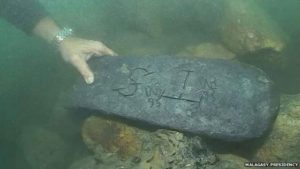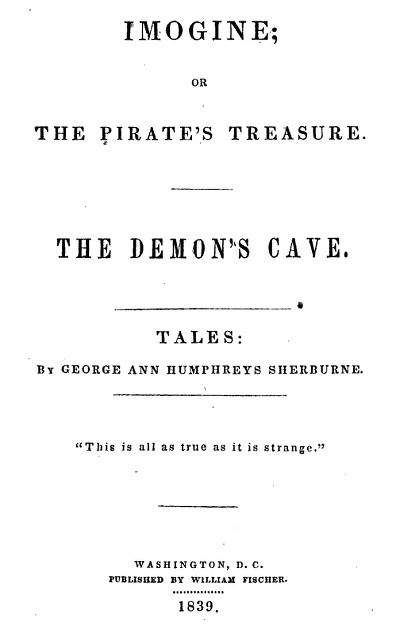It would be fair to say that the title of George Edmunds’ hefty book “Anson’s Gold and the Secret to Captain Kidd’s Charts” somewhat undersells its scope. Edmunds claims – as does his former research partner Ron Justron’s ‘Great Lost Treasure’, perhaps unsurprisingly – to have solved just about every treasure-related story going, including Ubilla’s treasure, Kidd’s (supposed) maps, The Loot of Lima, The Bosun Bird Treasure, Oak Island, Rennes-le-Chateau, Shugborough Hall, etc etc.
Even though Edmunds pulls his horse up in front of Becher’s Brook (i.e. Justron’s final assertions regarding Tintin and the Secret of the Unicorn, *sigh*), the two theorists’ oeuvres are otherwise difficult to slide a fag paper between, no matter how hard you sand it down. Perhaps experts at telling the People’s Front of Judea apart from the Judean People’s Front would find this easy: I struggled in many places.
Putting the issue of Ron Justron to one side, what is Edmunds’ actual argument that manages to take up his book’s whopping 585 pages?
Part 1 – Identifying Killorain
Edmunds starts by taking the Ubilla treasure story completely at face value: he then trawls through a large number of similar-sounding buried treasure stories, before identifying (or, rather, offering an identification for) the character Killorain.
To do this, he uses what he calls “Story DNA”, i.e. by tracing the fragments of narrative shared, copied and re-used between different buried-treasure stories, Edmunds tries to deduce the relationships between those stories, and to reach out towards the Ur-story buried beneath.
Even though there’s a half-germ of a research idea in what he’s attempting here, at no point in his (actually quite large) book does this ever translate into a research methodology (or even an approach to complex reasoning) that anyone could follow, reproduce or use, on this subject or on anything else.
For sure, Part 1 is the clearest of all his sections: but at the end of it all, it’s still clear as mud to me why Edmunds thinks there can only be a single way of interpreting all the slabs of text he has copied over from numerous different sources to yield his particular conclusion. Yes, I can see how Killorain might be the person Edmunds thinks he is: but it’s a weak, sprawling, unfocused argument that carries him there, and it’s just not written in a way that acknowledges other possibilities or helps readers to eliminate those other possibilities.
Edmunds writes with enthusiasm (and not a little bombast at times): but it would need a significantly sharper knife than his “Story DNA” to pierce these historical veils. Has he managed to identify the treasure Ur-story’s paternity here? No, not really, sorry. 🙁
Part 2 – Identifying the Band of Pirates
Here Edmunds again tries to use Story DNA to strip down the ‘Bosun Bird’, the Loot of Lima, Cocos Island Treasure, Mururoa Atoll Treasure (the same one that excited Ron Justron so much), and the Palmyra Island Treasure stories into their overlapping DNA fragments to identify the band of pirates behind the single (supposed) pirate treasure event from which all these stories were derived.
However, his argument here is terrifically speculative (and noticeably fuzzier and weaker than Part 1’s): and right at the end, Edmunds expands his scope yet further – he now also wants his argument to encompass “Masonic DNA”. By this he means things which sound as though they link to Masonic practices or Masonic history, if you (again) strip them down to their fragmentary parts.
Unfortunately, this latter half makes his argument sound exactly like the kind of paranoid Masonic delusions that have plagued just about every piece of writing on treasure maps for the last century. To the best of my knowledge, there is no historical evidence whatsoever that links Speculative Freemasonry to anything remotely like a genuine conspiracy involving treasure: everything written on the subject has been little more than a giant house of cards (sans Frank Underwood, of course) that a single committed sneeze would blow to the floor.
Hence this for me is where Edmunds’ book “jumps the shark”, i.e. the point where the reader’s sympathies towards the kind of thing Edmunds was attempting (however imperfectly) in Part 1 quickly drop to zero. “Story DNA” was already only as strong as the execution (and this itself was noticeably lacking): but his “Masonic DNA” is just wrong-headed, and on many different levels.
Part 3 – H. T. Wilkins Joins The Party
Here, Edmunds recaps some of his previous book on Captain Kidd’s treasure maps (“Kidd: The Search For His Treasure”), but links his conclusions with Juan Fernandez Island, Oak Island, Plum Island, and a convoluted account of how he believes prolific author Wilkins was the mastermind behind it all.
Errmmm… really? Really truly honestly? Wilkins-as-Svengali is the conceit that enables both Edmunds and Ron Justron to make anything they want to be true sound true (i.e. where Wilkins can only have genuinely copied document X from an original source) or anything that doesn’t fit their chosen narrative sound false (i.e. Wilkins must have cleverly concocted document Y to leave a trail of clues that only the Wisest of the Wise can recognize and see past).
This is, of course, hyper-selective wishful thinking (as opposed to anything that might approach critical evaluation, or indeed critical thought). What makes this even clearer is Geoff Bath’s very interesting series of books, for which Geoff managed to uncover a whole lot of Wilkins’ correspondence. In my opinion, Bath offered up a picture of Wilkins that was radically different from (and, I believe, a lot more accurate and evidentially-grounded) than the one in either of Edmunds’ books.
Yes, Wilkins surely did personally create many of the maps that appear in his books, complete with Alle Ye Olde-Fashionned Nonne-Sense Texte He Couldde Comme Uppen Wyth: but it beggars belief that Wilkins was such a genius that he caused everything to fall into place for Edmunds, by leaving a faint trail of breadcrumb clues to The Real Treasure that only someone who just happened to cross-reference all his different books might possibly notice.
Part 4 – Latcham and Guayacan
This is where Edmunds looks (somewhat cursorily, it has to be said) at the Guayacan treasure story written about by Richard Latcham (and yes, I do have a copy of the original book in Spanish).
I’m sorry, though: as a piece of supposed history, this story really sucks. And the extra letter (supposedly by Captain Cornelius Patrick Webb of the Unicorn) is enough to put anyone right off their soup.
To start to explain away the problems with this, Edmunds (or rather Ron Justron’s Latin teacher acquaintance) translated the Cornelius Webb letter back into Latin (from Wilkins’ supposed mistranslation) and then back into English: and then talks about star codes, alchemy, celestial navigation, and yet more Masonic DNA. All of which is then brought together in the kind of numeric over-wrangling typically employed by conspiracy nutters to prove whatever thing they wanted to prove in the first place. Not that I’m saying that Edmunds is one of those: but the problem here is that his argument doesn’t make it easy to tell the two apart.
Perhaps others will find themselves convinced by this, but it left me as stone cold as Stone Cold Steve Austin. In Antarctica. Eating cold soup.
Part 5 – Rennes-le-Chateau
In which Edmunds recaps Pierre Plantard’s Rennes-le-Chateau story: he concludes that it is nonsense, but based on a genuine document connected to Lord Anson. Which is like asking the reader to disconnect their brain into neutral before turning the page. *sigh*
Part 6 – Anson’s Monument
By this point I was finding it extremely difficult to find the will to turn the pages. Good luck if you want to try summarizing this.
Part 7 – Mathematical-Sounding Stuff
This part covers the Golden Ratio, spirals, hidden geometry, and all the other gee-whizz crop circle stuff they don’t teach you on a Maths degree. If it had any redeeming features, I didn’t manage to pick up on them: by now, the nausea was really quite overwhelming.
Incidentally, a short section on Spanish Treasure Codes reproduces some drawings from a 65-page 2004 book called “The Spanish Code to Treasure” by Lou Layton (now deceased): however, it’s extraordinarily hard to tell whether these are genuine or just wishful thinking.
Part 8 – Was This A Templar Treasure?
Errmmm… no, it wasn’t. Next!
Part 9 – “Well, That About Wraps It Up For God”
Fans of Hitchhiker’s Guide To The Galaxy will probably recognize the above as the title of one of Oolon Colluphid’s books. These were all characterized by foolish self-referential logic that purported to use the existence of God to prove His non-existence, e.g.:
“I refuse to prove that I exist,” says God, “for proof denies faith, and without faith I am nothing.”
“But,” says Man, “the Babel fish is a dead giveaway, isn’t it? It could not have evolved by chance. It proves that You exist, and so therefore, by Your own arguments, You don’t. QED”
Suffice it to say that, to my mind, this final part of Edmunds’ book – that applies Story DNA, Masonic DNA, star codes, numerology and abstruse numerical calculations to the Shugborough Hall Shepherds’ Monument to supposedly yield the precise longitude and latitude of a buried pirate treasure – reminds me strongly of Oolon Colluphid. And not in a flattering way.
But feel free to read “Anson’s Gold” for yourself and make up your own mind: for what do I know?


